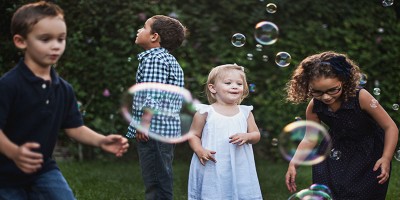Mixed-age groups refer to settings that bring together children aged three to five years old. Since children at different points in this age range may have different skills and abilities, working with mixed age groups may require service providers and educators to be more intentional in designing practices that meet the learning needs of all children. The following provides information on the Benefits Of Mixed Age Groups, Strategies For Working With Mixed Age Groups and more.
Benefits Of Mixed-Age Groups
Same-age groups are based on the conventional wisdom that children at the same age are ready to learn similar types of skills and concepts. However even such developmental models are careful about proposing learning milestones for a range of years rather than for a single age. More importantly, social learning theories underline how important it is for children to observe and interact with each other for learning to take place. And since mixed age groups include children at different developmental levels, they get opportunities to observe and learn a wider variety of skills.
Mixed-age grouping can provide older children with the opportunity to be helpful, patient and tolerant of younger peers' competencies. This gives them some of the desirable early experiences of being nurturing that underlie parenting and helping others who are different from themselves.
Younger recipients also benefit since exposure to older children as nurturers provides them with models of the behaviour they can emulate when they become the older members of a group.
Also, mixed age groups allow children more room to learn at their own pace as compared to same-age learning environments where each child has to keep the same pace as other children. In a mixed-age learning environment, children are more likely to be encouraged to focus on what they can do rather than what they can’t do. This gives children more freedom to develop their own strengths and abilities at the pace with which they are comfortable. Again since mixed-age groups have children with individual learning trajectories, it makes for a more cooperative than competitive environment.
Offering mixed-age groupings in a setting can provide stability for a group of children with their caregivers over a longer time. Known as continuity of care, this approach to providing consistency of relationships is critical in supporting secure attachment for babies and toddlers as well as development and learning for young children. In conventional same-age settings, children and families may have to adapt to a new setting, a new group of peers, and a new set of teachers several times during their enrolment. Mixed-age groupings on the other hand, facilitate deeper and more stable relationships for educators with children and their families. It also allows siblings and peer groups to remain together over time in a familiar setting, thereby providing for more stable social bonds.
Strategies For Working With Mixed Age Groups
- Offer flexible spaces and multi-use environments so that children of all ages can access resources, materials and experiences that match their interests and skills as well as those that challenge them to extend their capabilities. A useful strategy is to provide safe, open-ended materials that offer multiple uses for varying ages. When children have opportunities for self-directed play, they play longer, are more engaged, and play more independently.
- Plan differentiated experiences for children that allow them to learn at their own pace with individual support; for example, experiences such as playdough or water play that can cater for various levels of skill and provide easy ways for children to work together. However, at other times, educators may have to spend more time with some children to assist them with daily transitions, and routines or design specific intentional teaching practices to teach social and emotional skills.
- Use regular staff meetings to discuss the needs and interests of all children and to gather inputs from other staff at the centre, like early intervention professionals or centre nurses.
- Put in place-responsive mechanisms to listen to families about what they hope for their children’s learning. For example, if a parent expresses concern about their three-year-old making friends, educators will need to share the strategies they will use to support the child and make sure that documentation is shared that illuminates the child’s progress. Similarly, educators will also be expected to share learning strategies developed to support multi-age groups with families, as a way of helping them understand how their child will benefit from the program.
- Establish a culture of nurturing and care between the children. There may be some children who naturally look out for friends and they can be a great support and model in mixed-aged groups. However the importance of helping and caring for each other should be familiar to all children in the class and to bring this about, educators will have to use intentional teaching strategies. One way might be to establish calming spaces in the room where children can go to have some time to think and be quiet; other strategies can be focused on step-by-step processes that teach children what to do when someone is hurt or in trouble.
- Set up systems that enable children to support and lead learning; for example, a buddy system will not only offer young children opportunities to learn from an older peer but also provide ways of mutual support for others during routines like packing bags and wearing jackets when it is time to go home. However, it is important for educators to ensure that all children get an opportunity to lead others by observing and documenting children’s new skills or abilities. Appointing ‘experts’ is another way that mixed-age groups can provide peer learning support. Educators can identify children as relatively more skilled in particular areas such as puzzles, drawing or feeding the animals so that they can be nominated to lead less experienced peers. Such systems not only support learning in younger children but build the confidence of older children too as they get a chance to share their knowledge with others.
- Implement group management strategies to ensure smoother learning experiences and minimal disruptions in class; some ideas could be setting up the environment in a way that limits adults’ use of “no’s” or children’s need for constant guidance. For example, it would be easier to ensure safety by having more complex materials like paint, and child-safe scissors kept out of reach from younger children but within adult reach and ready for the older children to use. Also planning the curriculum around significant routines and transitions might help streamline much of the variability involved in mixed-age group behaviour. Again planning small group or individually based experiences rather than large-group activities might make it easier to manage mixed-age group behaviour. If needed, educators can make environmental or curricular adaptations to limit challenging behaviours since sometimes what adults perceive to be challenging, like a toddler’s mouthing of play equipment, are normal behaviours that are hard for adults to manage in a group setting.
In all these ways, mixed-age groups offer unique opportunities for learning and development. Children in these settings benefit from interactions with both younger and older peers, besides learning various social skills that can be used as they grow older.
Further Reading
Mixed Age Ratios In An Early Childhood Service - In a mixed age group of children, an educator who is caring for one age range of children can also be counted against another age range of children, as long as the ratio for each age range is maintained and adequate supervision is maintained at all times.
References:
- Multi-Age Groups, Department Of Education Victoria
- Mixed Age Groups Continuity Support, Head Start ELC
- Early Childhood Mixed Grouping, Wisconsin Department Of Education







 As an Educator in Australia, your pay rate falls under the Children’s Services Award 2010. This award states the minimum amount that an employer can
As an Educator in Australia, your pay rate falls under the Children’s Services Award 2010. This award states the minimum amount that an employer can When working as a qualified Early Childhood Teacher (with a university degree) within a service, your rate of pay will come from the Educational Services
When working as a qualified Early Childhood Teacher (with a university degree) within a service, your rate of pay will come from the Educational Services When working as a Diploma Qualified Educator your pay rate is from the Children's Services Award 2010. This Award states your minimum rate of pay
When working as a Diploma Qualified Educator your pay rate is from the Children's Services Award 2010. This Award states your minimum rate of pay When working as a Cert 3 Qualified Educator, your pay rate is from the Children's Services Award 2010. This Award states your minimum rate of
When working as a Cert 3 Qualified Educator, your pay rate is from the Children's Services Award 2010. This Award states your minimum rate of Educational Leaders play a crucial role in their early childhood service by ensuring that the educational program aligns with best practices and supports the holistic
Educational Leaders play a crucial role in their early childhood service by ensuring that the educational program aligns with best practices and supports the holistic In early childhood education and care, ratios are more than a technicality—they are a frontline safeguard. Every child deserves responsive supervision, emotional connection, and developmental
In early childhood education and care, ratios are more than a technicality—they are a frontline safeguard. Every child deserves responsive supervision, emotional connection, and developmental Here’s a comprehensive Mobile Phone and Smart Watch Policy tailored for early childhood education and care (ECEC) services in Australia, aligned with the latest 2025
Here’s a comprehensive Mobile Phone and Smart Watch Policy tailored for early childhood education and care (ECEC) services in Australia, aligned with the latest 2025 With the new national child safety reforms kicking in on 1 September 2025, early childhood services like yours have a real opportunity to lead the
With the new national child safety reforms kicking in on 1 September 2025, early childhood services like yours have a real opportunity to lead the The Sea of Fish Challenge is a national initiative that invites children, educators, families, and communities to create and display fish artworks as a symbol
The Sea of Fish Challenge is a national initiative that invites children, educators, families, and communities to create and display fish artworks as a symbol Across the early childhood education and care sector, educators are sounding the alarm: current staffing ratios are insufficient to deliver safe, meaningful, and developmentally appropriate
Across the early childhood education and care sector, educators are sounding the alarm: current staffing ratios are insufficient to deliver safe, meaningful, and developmentally appropriate


